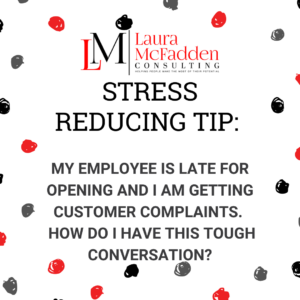
How to have a tough conversation.
You know in order to have a successful conversation with someone, you must plan it out. Now, it’s time to start talking – what do you do?
Since you have done so much thinking and have planned for the conversation, it is easy to dive right into your perceptive of a solution. However, the employee you are speaking to hasn’t had time to prepare and plan like you have. How do you think the conversation will go? She will probably become defensive and your goal of having clarity will decrease significantly. So, how can you handle this situation?
What do I say to start the conversation?
Start by sharing your observations and asking questions. Explain what you have observed to help her understand why you are bringing this up. Then move into questions to help build clarity around the situation. The immediate goal is for you to understand why the behavior is happening first, later in the conversation you can focus on a mutually agreed upon solution.
Let me give you an example. An employee is the opener at a retail store and has been late for the last two weeks causing customers to wait to come in. At first, you heard about it from other employees and then you had a customer complain about it. You have now decided to see for yourself what is happening, so you start to arrive at the opening as well. Sure enough, the employee has been late. After planning the conversation and determining it is important to discuss you schedule a meeting.
Example
The conversation should begin something like this:
Boss: Thank you for taking the time to meet with me today. I have some observations I would like to share if that is okay?
Employee: Sure boss, what’s up?
Boss: Here is the schedule and, on these dates, I was here to open, however, you were not here yet. Do you remember those dates?
Employee: yes.
Boss: You are one of my strongest openers and I would like to understand what is happening. Can you share with me your thoughts?
Next, allow the employee to share what has been happening. Listen for clarity of the situation. Remember, in your planning you thought about potential reasons, and you did that in order to help build questions to gain understanding. At this point, listen for what might be causing the situation and be prepared to dig deeper with questions to help find a resolution. Only after you understand the cause from the employee’s point of view would you start to move the conversation towards finding a mutually agreed upon solution.
Why is this conversation strategy important?
As a leader, if you have developed rapport and trust with your staff taking the approaching of asking for their perspective will feel natural for both of you. It will show 1) you care, 2) you respect your employee’s input and 3) as part of the team your goal is to help make it possible for everyone to succeed.
What ideas do you have regarding this approach? Next time you are faced with a tough conversation, consider giving this strategy a try.

Recent Comments